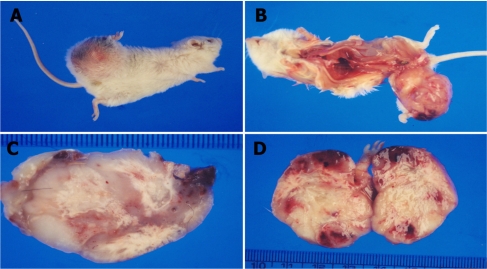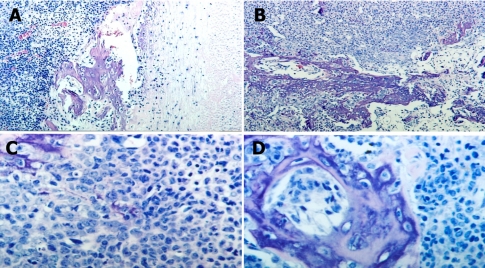Lab Anim Res.
2011 Sep;27(3):251-254. 10.5625/lar.2011.27.3.251.
Spontaneous osteosarcoma of the femur in a non-obese diabetic mouse
- Affiliations
-
- 1Center for Animal Resources Development, Wonkwang University, Iksan, Korea. kimoj@wku.ac.kr
- 2Department of Companion Animal and Animal Recourses Science, Joongbu University, Geumsan, Korea.
- 3Institute of Biotechnology, Wonkwang University, Iksan, Korea.
- KMID: 1850053
- DOI: http://doi.org/10.5625/lar.2011.27.3.251
Abstract
- An abnormal swelling was identified in the distal portion of the right femur in a 1-year-old non-obese diabetic (NOD) mouse. Grossly, a large mass of the distal femur was observed in the right femur. Lesions were poorly marginated, associated with destruction of the cancellous and cortical elements of the bone, and showed ossification within the soft tissue component. Histologically, the tumor was identified as a poorly differentiated sarcoma. Histopathologic examination of the bone masses revealed invasive proliferation of poorly differentiated neoplastic mesenchymal cells forming streams, bundles, and nests, which resulted in destruction of normal bone. Neoplastic cells exhibited random variation in cellular appearance and arrangement, as well as matrix composition and abundance. Haphazard and often intermingling patterns of osteogenic, chondroblastic, lipoblastic, and angiogenic tissues were present. Larger areas of neoplastic bone and hyaline cartilage contained multiple large areas of hemorrhage and necrosis bordered by neoplastic cells. The mass was diagnosed as an osteosarcoma. To our knowledge, this is the first spontaneous osteosarcoma in an NOD mouse.
Keyword
MeSH Terms
Figure
Reference
-
1. Huvos A. Bone Tumors: Diagnosis, Treatment, Prognosis. 1991. 2nd ed. Philadelphia: WB Saunders;p. 784.2. Sissons HA. The WHO classification of bone tumors. Recent Results Cancer Res. 1976; (54):104–108. PMID: 1070715.
Article3. McKenna RJ, Schwinn CP, Soong KY, Higinbotham NL. Sarcomas of the osteogenic series (osteosarcoma, chondrosarcoma, parosteal osteogenic sarcoma, and sarcomata arising in abnormal bone): an analysis of 552 cases. J Bone Joint Surg Am. 1966; 48(1):1–26.4. Gurney JG, Swensen AR, Bulterys M. Ries LA, editor. Malignant bone tumors. Cancer Incidence and Survival Among Children and Adolescents: United States SEER Program 1975-1995. 1999. Bethesda: National Cancer Institute;p. 99–110.5. Smith MA, Gurney JG, Ries LA. Ries LA, editor. Cancer in adolescents 15 to 19 years old. Cancer Incidence and Survival among Children and Adolescents: United States SEER Program 1975-1995. 1999. Bethesda: National Cancer Institute;p. 111–200.6. Stiller CA, Bielack SS, Jundt G, Steliarova-Foucher E. Bone tumours in European children and adolescents, 1978-1997. Report from the automated childhood cancer information system project. Eur J Cancer. 2006; 42(13):2124–2135. PMID: 16919776.
Article7. Brodey RS, Riser WH. Canine osteosarcoma: a clinicopathologic study of 194 cases. Clin Orthop Relat Res. 1969; 62:54–64. PMID: 5251443.8. Jones RD, Reid R, Balakrishnan G, Barrett A. Multifocal synchonous osteosarcoma: the Scottish bone tumour registry experience. Med Pediatr Oncol. 1993; 21(2):111–116. PMID: 8433676.9. Moore A. Osteosarcoma in dogs: managing a destructive disorder. Vet Med. 2001; 96(7):539–546.10. Thompson KG, Pool RR. Meuten DJ, editor. Tumors of bone. Tumors in Domestic Animals. 2002. Ames: Iowa State Press;p. 245–283.11. Watson C, Lucroy M. Primary appendicular bone tumors in dogs. Comp Cont Ed Pract Vet. 2002; 24(2):128–138.12. LaRue SM, Withrow SJ, Wrigley RH. Radiographic bone surveys in the evaluation of primary bone tumors in dogs. J Am Vet Med Assoc. 1986; 188(5):514–516. PMID: 3457000.13. Misdorp W, Hart AA. Some prognostic and epidemiologic factors in canine osteosarcoma. J Natl Cancer Inst. 1979; 62(3):537–545. PMID: 283283.
Article14. Albassam MA, Courtney CL. Mohr U, editor. Non-neoplastic and neoplastic of the bone. Pathology of the Aging Mouse. 1996. Washington DC: ILSI press;p. 425–437.15. Wadsworth PF. Mohr U, editor. Classification of bone neoplasms and presentation of data on the incidence and types in C57BL/10J mice. Pathology of the Aging Mouse. 1996. Washington DC: ILSI press;p. 439–443.16. Frith CH, Johnson BP, Highman B. Osteosarcomas in BALB/c female mice. Lab Anim Sci. 1982; 32(1):60–63. PMID: 6952039.17. Frith CH, Littlefield NA, Umholtz R. Incidence of pulmonary metastases for various neoplasms in BALB/cStCrlf C3H/Nctr female mice fed N-2-fluorenylacetamide. J Natl Cancer Inst. 1981; 66(4):703–712. PMID: 6262551.18. Maita K, Hirano M, Harada T, Mitsumori K, Yoshida A, Takahashi K, Nakashima N, Kitazawa T, Enomoto A, Inui K, Shirasu Y. Mortality, major cause of moribundity, and spontaneous tumors in CD-1 mice. Toxicol Pathol. 1988; 16(3):340–349. PMID: 3194656.
Article19. Long PH, Leininger JR. Maronpot RR, editor. Bones, joints, and synovial. Pathology of the Mouse. 1999. Vienna: Cache River Press;p. 645–678.20. Slayter MV, Boosinger TR, Pool RR, Dammrich K, Misdorp W, Larsen S. Malignant tumors. World Health Organization Histologic Classification of Bone and Joint Tumors of Domestic Animals. 1994. Washington DC: Armed Forces Institute of Pathology, American Registry of Pathology and the World Health Organization Collaborating Center for Comparative Oncology;p. 7–11.21. Moore GE, Mathey WS, Eggers JS, Estep JS. Osteosarcoma in adjacent lumbar vertebrae in a dog. J Am Vet Med Assoc. 2000; 217(7):1038–1040. PMID: 11019712.
Article22. Thrall DE. Thrall DE, editor. Bone tumors versus bone infections. Textbook of Veterinary Diagnostic Radiology. 1998. Philadelphia: WB Saunders;p. 161–168.23. Vigorita VJ. Vigorita VJ, editor. Bone tumors. Orthopaedic Pathology. 1999. Philadelphia: Lippincott Williams and Wilkins;p. 1–345.
- Full Text Links
- Actions
-
Cited
- CITED
-
- Close
- Share
- Similar articles
-
- A Case of Osteosarcoma Developed in a Patient of Untreated Bilateral Retinoblastoma
- Osteosarcoma Arising in Monostotic Fibrous Dysplasia of the Femur: A Case Report
- Osteosarcoma of the Patella (1 Case)
- Spontaneous Pneumothorax as a Complication of Pulmonary Metastasis of Osteosarcoma A case report
- Primary osteosarcoma of both distal femur: A case report



